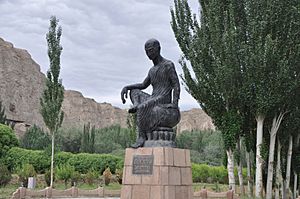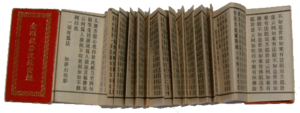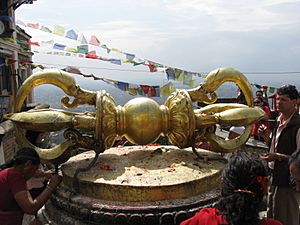Diamond Sutra facts for kids
The Diamond Sutra (Sanskrit: Vajracchedikā Prajñāpāramitā Sūtra) is an important Buddhist text from a group of scriptures called Prajñāpāramitā sutras. These texts focus on "the perfection of wisdom." The Diamond Sutra is one of the most important Mahāyāna Buddhist texts in East Asia. It is especially popular in the Chan (also known as Zen) tradition, along with the Heart Sutra.

A very old copy of the Chinese Diamond Sūtra was found in 1900 among the Dunhuang manuscripts. These ancient papers were discovered by a Daoist monk named Wang Yuanlu. In 1907, he sold them to Aurel Stein. This copy is dated to May 11, 868 CE. The British Library calls it "the earliest dated printed book" known to exist.
This book is also special because it is the first known creative work that was made "for universal free distribution." This means it was meant to be shared freely with everyone.
Contents
What is the Diamond Sutra's Name?
The full Sanskrit name for the text is Vajracchedikā Prajñāpāramitā Sūtra. This long name can be translated as "The Perfection of Wisdom Text that Cuts Like a Thunderbolt."
The word "Vajra" can mean "diamond" or "thunderbolt." It is also a term for a powerful weapon. The title uses the idea of a diamond or thunderbolt cutting through things. This is a way to describe wisdom that can cut through false ideas and show the true nature of reality.
In English, people often use shorter names like Diamond Sūtra or Vajra Sūtra. The text is also sometimes called "Triśatikā Prajñāpāramitā Sūtra," which means the "300 lines Perfection of Insight sutra."
The Diamond Sūtra is highly respected in East Asian countries where Mahayana Buddhism is practiced. Here are some of its names in other languages:
- Chinese: 金剛般若波羅蜜多經 (Chinese); shortened to 金剛經
- Japanese: 金剛般若波羅蜜多経 (Japanese); shortened to 金剛経
- Korean: 금강반야바라밀경 (Korean); shortened to 금강경
- Vietnamese: Kim cương bát-nhã-ba-la-mật-đa kinh (Vietnamese); shortened to Kim cương kinh
When Was the Diamond Sutra Written?
We are not exactly sure when the Diamond Sūtra was first written in Sanskrit. Some experts think it was around the 2nd century, while others suggest the 5th century.
The first Chinese translation of the Diamond Sūtra was made in 401 CE. It was done by a famous and skilled translator named Kumārajīva. His translations are known for being smooth and easy to understand. They focus on the meaning rather than a word-for-word translation.
Kumārajīva's translation has been very popular for centuries. It is the same version found on the 868 CE Dunhuang scroll, which is the oldest dated printed book. This version is still the most widely used and chanted Chinese version today.
Many other translations into Chinese were made after Kumārajīva's. For example, Bodhiruci translated it in 509 CE, and Xuanzang translated it twice in the 7th century.
The Diamond Sūtra became very important in East Asian Buddhism. People created artwork inspired by it, showed great respect for the text, and wrote many explanations (commentaries) about it. By the end of the Tang Dynasty (907 CE) in China, over 80 commentaries had been written.
One of the most famous commentaries was written by Huineng, who was a very important leader in the Chan (Zen) school of Buddhism. The Diamond Sutra plays a big role in the story of Huineng's life. It is said that hearing a part of the Diamond Sutra helped him gain a deep understanding that led him to become a Buddhist monk.
What Does the Diamond Sutra Teach?
The Diamond Sutra tells the story of a conversation between the Buddha and an older monk named Subhuti. The main ideas in the text are:
- Not-self (anatman): The idea that there is no fixed, unchanging "self" or "soul."
- Emptiness (śūnyatā): The teaching that all things are empty of a separate, lasting nature. They depend on other things to exist.
- Helping all beings: The importance of helping all living beings find peace and freedom, without being attached to the idea of "me" or "them."
- Sharing the teachings: The importance of spreading and teaching the Diamond Sūtra itself.
According to a Buddhist teacher named Hsing Yun, the sutra teaches four main points:
- Giving to others without being attached to yourself.
- Helping beings without thinking of "self" or "other."
- Living without being overly attached to things.
- Practicing spiritual growth without expecting to gain something.
The main goal of the Diamond Sūtra is to help people understand reality as it truly is. It aims to free us from the mistaken idea that things are solid and separate.
In the sutra, the Buddha finishes his daily walk to gather food and sits down to rest. Subhuti asks the Buddha: "How should someone who wants to follow the path of a bodhisattva (someone who aims to help all beings) act? How should they control their mind?"
The Buddha explains that he will guide all living beings to a state of perfect peace (nirvana). But then he says, "no living being whatsoever has been brought to extinction." This sounds confusing, but the Buddha means that a bodhisattva does not see beings as separate "persons" or "souls." Instead, they see them with perfect understanding, knowing that all things are empty of a fixed, unchanging self.
The Buddha continues to make similar statements. He uses a way of speaking that says something "is not" what it seems to be. For example, he says:
- "All 'dharmas' (teachings or phenomena) are actually dharma-less. That is why they are called 'all dharmas'."
- "So-called 'streams of thought' are actually streamless. That is why they are called 'streams of thought'."
- "All 'beings' are actually beingless. That is why they are called 'all beings'."
The Buddha is trying to help Subhuti let go of his old, limited ideas about reality. He teaches that everything is ultimately like an illusion. True wisdom comes when you let go of being attached to these illusions.
The sutra also explains that language can make us think that ideas are fixed and real. But true wisdom is seeing that nothing is fixed or stable. So, an enlightened person would not think, "I have reached enlightenment." This is because such a thought would be holding onto a false idea of a "self" or "person."
The Diamond Sutra says that anyone who thinks they have gained something like the state of an Arhat (a perfected person) is not truly a bodhisattva. The goal is to use words for their practical meaning, but not to believe that the words themselves represent something absolutely real and unchanging.
The mind of someone who practices "perfection of insight" is free from fixed ideas about a "self":
However, Lord, the idea of a self will not occur to them, nor will the idea of a living being, the idea of a soul, or the idea of a person occur. Why is that? Any such idea of a self is indeed idealess, any idea of a living being, idea of a soul, or idea of a person is indeed idealess. Why is that? Because the Buddhas and Lords are free of all ideas.
The Buddha often repeats that remembering and explaining even a small part of the Diamond Sutra brings great good fortune. It is better than giving many gifts and can even lead to enlightenment.
The Chinese version of the sutra ends with a famous four-line poem:
All conditioned phenomena
Are like a dream, an illusion, a bubble, a shadow,
Like dew or a flash of lightning;
Thus we shall perceive them.
Another translation of this poem says:
So you should view this fleeting world—
A star at dawn, a bubble in a stream,
A flash of lightning in a summer cloud,
A flickering lamp, a phantom, and a dream.
The Dunhuang Printed Copy
The British Library has a woodblock-printed copy of the Diamond Sutra. While it's not the very first example of block printing, it is the earliest one that has a clear date printed on it.
This copy is a scroll about 5 meters (about 16 feet) long. An archaeologist named Sir Marc Aurel Stein bought it in 1907. He found it in the Mogao Caves near Dunhuang in northwest China. These caves are also known as the "Caves of the Thousand Buddhas."
At the end of the scroll, there is a note that says:
Reverently made for universal free distribution by Wang Jie on behalf of his two parents on the 15th of the 4th moon of the 9th year of Xiantong [11 May 868].
In 2010, experts from the British Library worked to restore this important book. You can view the entire Diamond Sūtra on the British Library's website.
Images for kids
See also
 In Spanish: Sutra del diamante para niños
In Spanish: Sutra del diamante para niños
- Science and technology of the Tang Dynasty







